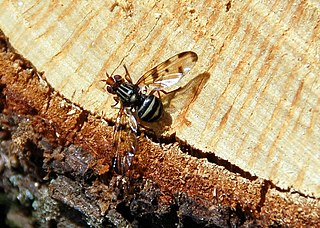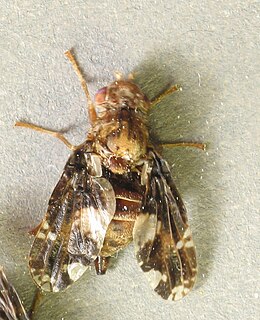
The Ulidiidae or picture-winged flies are a large and diverse cosmopolitan family of flies (Diptera), and as in related families, most species are herbivorous or detritivorous. They are often known as picture-winged flies, along with members of other families in the superfamily Tephritoidea that have patterns of bands or spots on the wings. Some species share with the Tephritidae an unusual elongated posteroapical projection of the anal cell in the wing, but can be differentiated by the smoothly curving subcostal vein. Two species, Tetanops myopaeformis and Euxesta stigmatias, are agricultural pests.

Hybotidae, the typical dance flies, are a family of true flies. They belong to the superfamily Empidoidea and were formerly included in the Empididae as a subfamily.
Acrotaenia is a genus of tephritid or fruit flies in the family Tephritidae.

Terellia is a genus of tephritid or fruit flies in the family Tephritidae.
Tritoxa cuneata is a species of picture-winged fly in the genus Tritoxa of the family Ulidiidae.

Tritoxa incurva is a species of picture-winged fly in the genus Tritoxa of the family Ulidiidae.
Tritoxa pollinosa is a species of picture-winged fly in the genus Tritoxa of the family Ulidiidae.
Tritoxa ra is a species of picture-winged fly in the genus Tritoxa of the family Ulidiidae.

Tritoxa flexa is a species of picture-winged fly in the genus Tritoxa of the family Ulidiidae.
Chymophila is a subgenus of the hoverfly genus Microdon. It was previously considered to be exclusively Neotropical, but is now also known from the Nearctic and Oriental realms, and one species is known from Japan. Chymophila was based on a composite type species: the holotype is a body of C. fulgens with the head of a conopid glued on.
Timia is a genus of flies in the family Ulidiidae, which is difficult to separate from the genus Ulidia.

Otitinae is the name of a subfamily of flies in the family Ulidiidae. It was formerly the Otitidae. Like the Ulidiinae, most species are herbivorous or saprophagous. Most species share with the Tephritidae an unusual elongated projection of the anal cell in the wing, but can be differentiated by the smoothly curving subcostal vein. Most are dull gray to shiny brown or black flies with vein R1 setulose or, in a few cases, bare.

Eurosta is a genus of gall maker flies in the family Tephritidae. There are seven species in the genus, all in North America.

Sepedon is a genus of flies in the family Sciomyzidae, the marsh flies or snail-killing flies.
Ortalis is an historic genus of Ulidiid or picture-winged flies, first described by Fallén in 1810. It served as the type genus for the family Ulidiidae, which was called Ortalidae at the time. In 1932, it was pointed out by Adlrich that the name Ortalis was preoccupied by a genus of birds which had been named by Merrem in 1786. The name of the fly family was therefore revised, with some authors calling it Otitidae until Ulidiidae was settled on as standard. The genus itself was found to be paraphyletic, and all of its species have been reassigned to other genera, some in the Ulidiidae, and some in other Tephritoid families. In the following list, the species are organized according to the families and genera to which they have been reassigned.

Lauxania is a genus of small flies of the family Lauxaniidae.

Cephaliini is a tribe of picture-winged flies in the family Ulidiidae.
Tritoxa californica is a species of picture-winged fly in the genus Tritoxa of the family Ulidiidae.
Tritoxa decipiens is a species of picture-winged fly in the genus Tritoxa of the family Ulidiidae.








